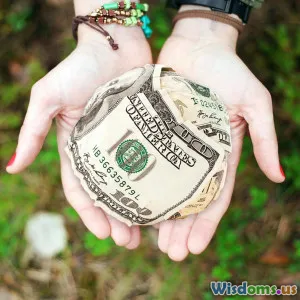
Is Generosity Really the Secret to Wealth Creation
8 min read Exploring how generosity influences wealth creation through science, psychology, and real-world examples. (0 Reviews)
Is Generosity Really the Secret to Wealth Creation?
We live in an age where wealth is often equated to accumulation: more money, more possessions, more power. But is that the full story? What if generosity — the act of giving without expecting immediate returns — is actually one of the most powerful drivers of long-term wealth creation? This idea contradicts traditional views but finds root in psychology, economics, and countless real-world success stories.
In this article, we will explore the nuanced relationship between generosity and wealth through multiple lenses. The goal is to unpack the true impact of generosity on personal finances, business success, and community prosperity.
The Psychological Foundations of Generosity and Wealth
The Science of Generosity: A Win-Win Game
Scientific research consistently confirms that generosity offers psychological and physiological benefits that indirectly nurture wealth creation:
-
Dopamine and endorphin release: Acts of giving trigger the release of "feel-good" neurotransmitters, often called the "helper’s high." This improves mood, reduces stress, and positively influences decision-making skills (Dunn, Aknin, & Norton, 2008).
-
Social capital building: Giving strengthens relationships. According to Robert Putnam's research in Bowling Alone, strong social networks provide important resources, such as information, trust, and reciprocal help.
-
Better health and longevity: Studies indicate that people who regularly give are healthier and live longer, reducing future healthcare costs and maintaining productivity (Post, 2005).
This psychological foundation explains how generosity creates an internal cycle that supports resilience, creativity, and opportunities — essential ingredients for wealth over time.
Real-World Illustration: The ‘Pay-it-Forward’ Phenomenon
In cities worldwide, the “pay-it-forward” coffee or meal has become a popular example of generosity creating community goodwill. Customers pay for another’s purchase anonymously, inspiring chain reactions of kindness.
Though subtle, these acts also create positive social environments where businesses thrive because neighborhood trust develops—illustrating generosity's broader societal impact on economic ecosystems.
Economic Theories Supporting Generosity as a Wealth Strategy
The Concept of Prosocial Behavior in Economic Success
Prosocial behavior — voluntary actions intended to benefit others — is increasingly acknowledged as an economic asset. Nobel laureate economist Elinor Ostrom demonstrated that groups managing commons through cooperation and generosity outperform those driven purely by self-interest.
This insight aligns with behavioral economics’ critique of the purely rational agent model, suggesting giving can lead to emergent benefits like enhanced reputation and trustworthiness, which facilitate wealth accumulation.
Business Models Rooted in Generosity
Leading corporations, such as Patagonia and TOMS Shoes, integrate giving into their business DNA — committing portions of profits to social causes. This improves customer loyalty and brand equity. For example:
-
TOMS’ One for One program donated over 96 million pairs of shoes, simultaneously generating global brand recognition and business success.
-
Patagonia’s environmental activism builds customer trust and results in a devoted customer base willing to pay premium prices.
These companies demonstrate how generosity over time translates into financial gains and long-term sustainability.
Generosity’s Role in Personal Wealth Creation
Charitable Giving as a Strategic Financial Tool
Generosity isn't just philanthropy’s domain—it can be a smart fiscal strategy. For example:
-
Tax Benefits: Charitable contributions can provide tax deductions that improve financial efficiency.
-
Network Expansion: Donating and volunteering open social networks that can translate into professional and financial opportunities.
-
Mindset Shift: Financial advisors like Dave Ramsey emphasize giving as a cornerstone for healthy money management, reducing anxiety and promoting disciplined saving and investing.
Case Study: Warren Buffett and the Giving Pledge
Billionaire Warren Buffett, one of the world’s wealthiest individuals, pledged to give away over 99% of his wealth. Paradoxically, this commitment galvanized his financial legacy and the philanthropic ecosystem. His generosity influenced tax laws, encouraged others to donate, and enhanced his reputation for integrity—demonstrating how generosity can complement, rather than detract from, wealth creation.
Generosity as a Catalyst for Community Wealth
Cooperatives and Community Lending
Beyond the individual, generous financial structures like credit unions and community cooperatives illustrate wealth creation via shared resources and care. They often provide low-interest loans, fostering entrepreneurship and economic development within underserved areas.
Microfinance Revolution
Muhammad Yunus, Nobel Peace Prize laureate, revolutionized wealth creation through microcredit programs that empower the poor — particularly women — to start small businesses. These programs harness generosity with operational rigor, transforming lives by providing capital where traditional investors often shy away.
Caution: Generosity Without Boundaries Can Be Risky
While generosity is potent, it must be practiced wisely.
-
Responsible giving: Avoid overextending finances. Generosity balanced with financial literacy prevents burnout and debt.
-
Impact-focused: Giving with clear goals leads to sustainable results, such as investing in education or healthcare.
-
Reciprocity and recognition: Generosity that fosters mutual benefit builds enduring relationships. One-sided generosity, however well-intended, risks exploitation.
Conclusion: The Generosity-Wealth Connection — A Multifaceted Truth
Generosity is far more than charity; it’s a profound catalyst in wealth creation. Through improved psychological wellbeing, social capital, enhanced trust, and increased opportunities, generosity fuels sustainable financial success.
Real-life examples, from corporate philanthropy to local economies, reflect generosity as an investment with dividends paid in tangible and intangible forms. Importantly, generosity does not mean ignoring self-care or financial prudence — it requires balance and intentionality.
In a world urgently requiring both personal success and collective well-being, generosity may just be the secret ingredient to not only create wealth but to redefine its meaning for a richer, kinder society.
Take Action: Consider integrating generosity into your wealth-building strategy. Start small — volunteer, give thought-out financial gifts, or build generosity into your business model. Over time, watch generosity open doors you never imagined, transforming not just your finances but your life and community.
Rate the Post
User Reviews
Popular Posts

















